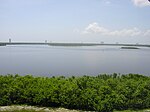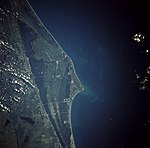Cape Canaveral Launch Complex 13

Launch Complex 13 (LC-13) was a launch complex at Cape Canaveral Space Force Station, the third-most southerly of the original launch complexes known as Missile Row, lying between LC-12 and LC-14. In 2015, the LC-13 site was leased by SpaceX and was renovated for use as Landing Zone 1 and Landing Zone 2, the company's East Coast landing location for returning Falcon 9 and Falcon Heavy launch vehicle booster stages. It is leased by US Space Force to Phantom Space and Vaya Space who will operate this launch complex after the termination of SpaceX's lease in future.LC-13 was originally used for test launches of the SM-65 Atlas and subsequently for operational Atlas launches from 1958 to 1978. It was the most-used and longest-serving of the original four Atlas pads. It was inactive between 1980 and 2015. On 16 April 1984, it was added to the US National Register of Historic Places; however it was not maintained and gradually deteriorated. On 6 August 2005 the mobile service tower was demolished as a safety precaution due to structural damage by corrosion. The blockhouse was demolished in 2012.LC-13 was on land owned by the US government and was originally controlled by the United States Air Force. It was transferred to NASA in 1964 and back to the Air Force in 1970. In January 2015, the land and remaining facilities at LC-13 were leased to SpaceX for a five-year lease.
Excerpt from the Wikipedia article Cape Canaveral Launch Complex 13 (License: CC BY-SA 3.0, Authors, Images).Cape Canaveral Launch Complex 13
ICBM Road,
Geographical coordinates (GPS) Address Nearby Places Show on map
Geographical coordinates (GPS)
| Latitude | Longitude |
|---|---|
| N 28.4859 ° | E -80.5444 ° |
Address
ICBM Road
Florida, United States
Open on Google Maps










